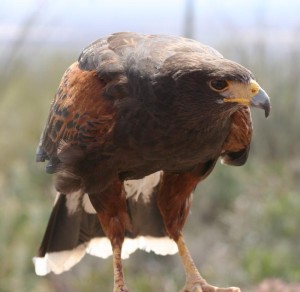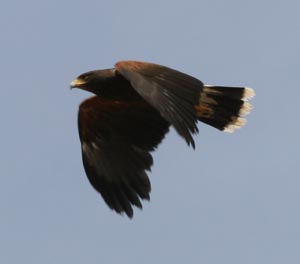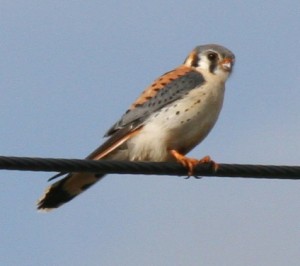Harris Hawk
The Harris Hawk, also known as the Harris’s Hawk or the Bay-winged Hawk, is a medium-sized bird of prey native to the Americas. Its scientific name is Parabuteo unicinctus, and it is a member of the Buteoninae subfamily of hawks. Harris Hawks are highly social birds and are known for their unique hunting strategies, making them a popular species among birdwatchers and falconers alike.
General Information:
The Harris Hawk is a relatively large bird, with a wingspan of up to 1.2 meters (4 feet) and a body length of up to 56 cm (22 inches). They have a distinctive black cap and a reddish-brown body with white on their legs, chest, and shoulders. Their wings are broad and rounded, and they have a long tail that is barred with white and black.
How to Identify:
Harris Hawks are easily identified by their unique coloration and social behavior. Their reddish-brown bodies with white on their legs, chest, and shoulders, along with their black cap and barred tail, make them stand out in the sky. They are also highly social birds, often seen in groups of 2-6 birds hunting together.
Preferred Habitat:
Harris Hawks prefer arid and semi-arid habitats, such as deserts, grasslands, and savannas. They are often found in open areas with scattered trees or shrubs, which provide perches for hunting and nesting.
Range:
Harris Hawks are native to the Americas, ranging from the southwestern United States to South America. They are found in countries such as Mexico, Argentina, and Chile, and are the most common hawk in Central America.
Migration:
Harris Hawks are not migratory birds, and they are considered year-round residents in their preferred habitats.
Food:
Harris Hawks are opportunistic predators and will hunt a wide range of prey, including birds, mammals, reptiles, and insects. They are often seen hunting in groups, with one bird flushing prey while the others wait to strike. They are also known to hunt cooperatively with other birds, such as the Crested Caracara, to take down larger prey.
Mating:
Harris Hawks are monogamous and typically mate for life. During courtship, the male performs aerial displays, including high circling flights and steep dives, to impress the female.
Nesting:
Harris Hawks typically build their nests in the forks of trees, shrubs, or cacti. They are also known to use artificial structures, such as power poles or buildings. The female lays 2-4 eggs, which both parents will incubate for about a month.
Egg Description:
Harris Hawk eggs are white and oval-shaped, measuring about 50 mm (2 inches) in length and 40 mm (1.5 inches) in width.
Raising Young:
Both parents will care for the young, bringing them food and defending the nest from predators. The young fledge after about 6-7 weeks and will continue to be cared for by the parents for several more weeks. Harris Hawks are known to be cooperative breeders, with other members of the family group helping to care for the young.
In conclusion, the Harris Hawk is a fascinating bird of prey with unique social behaviors and hunting strategies. Their preference for arid habitats and cooperation with other birds make them a truly remarkable species to observe in the wild.
Sources:
BirdLife International. (2018). Parabuteo unicinctus. The IUCN Red List of Threatened Species 2018: e.T22696356A132054180. https://dx.doi.org/10.2305/IUCN.UK.2018
 any other Jay sized bird. The only really distinguishing aspect of the American Kestrel’s silhouette is its beak – close to its face and hooked. If you stop and look, you will be surprised at how many you see. The American Kestrel is the most abundant falcon in North America.
any other Jay sized bird. The only really distinguishing aspect of the American Kestrel’s silhouette is its beak – close to its face and hooked. If you stop and look, you will be surprised at how many you see. The American Kestrel is the most abundant falcon in North America.